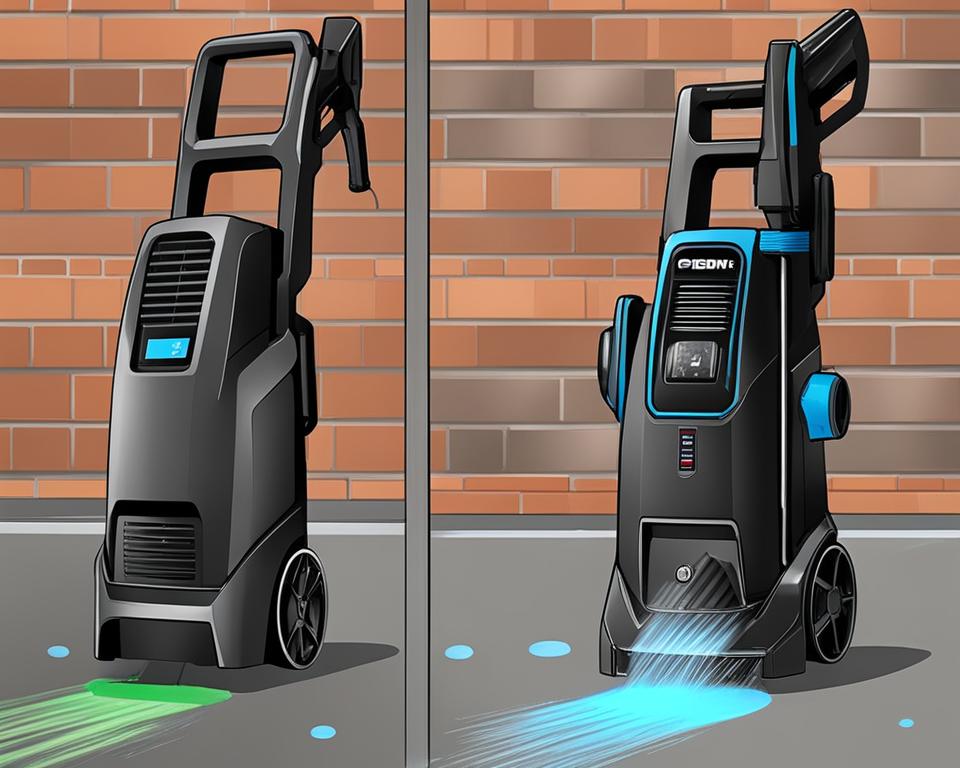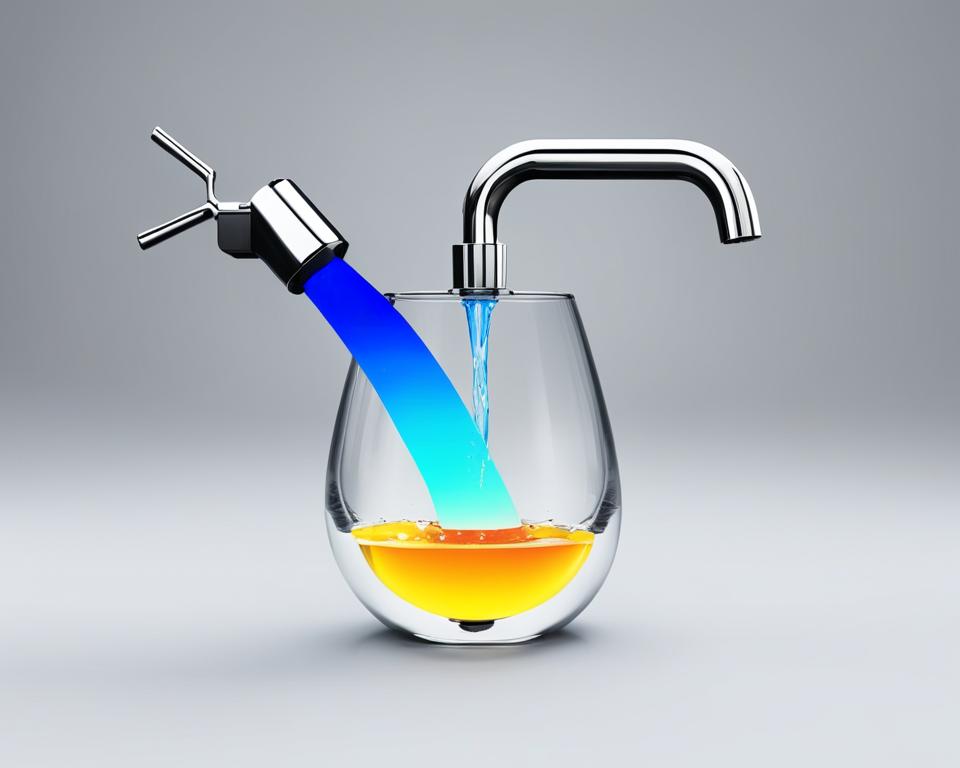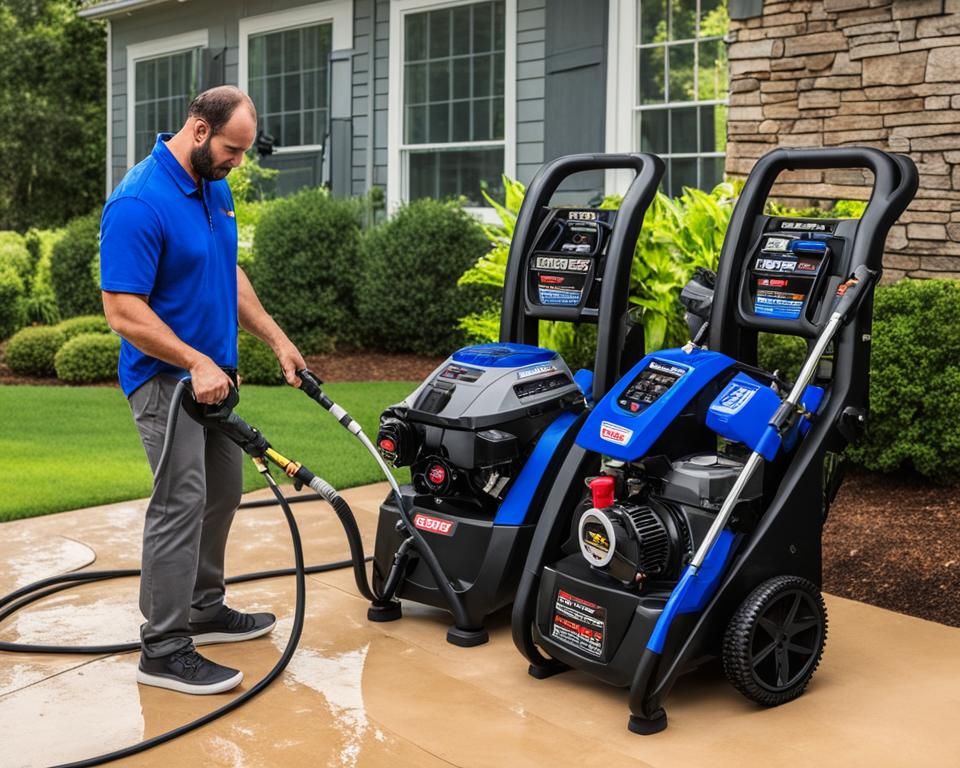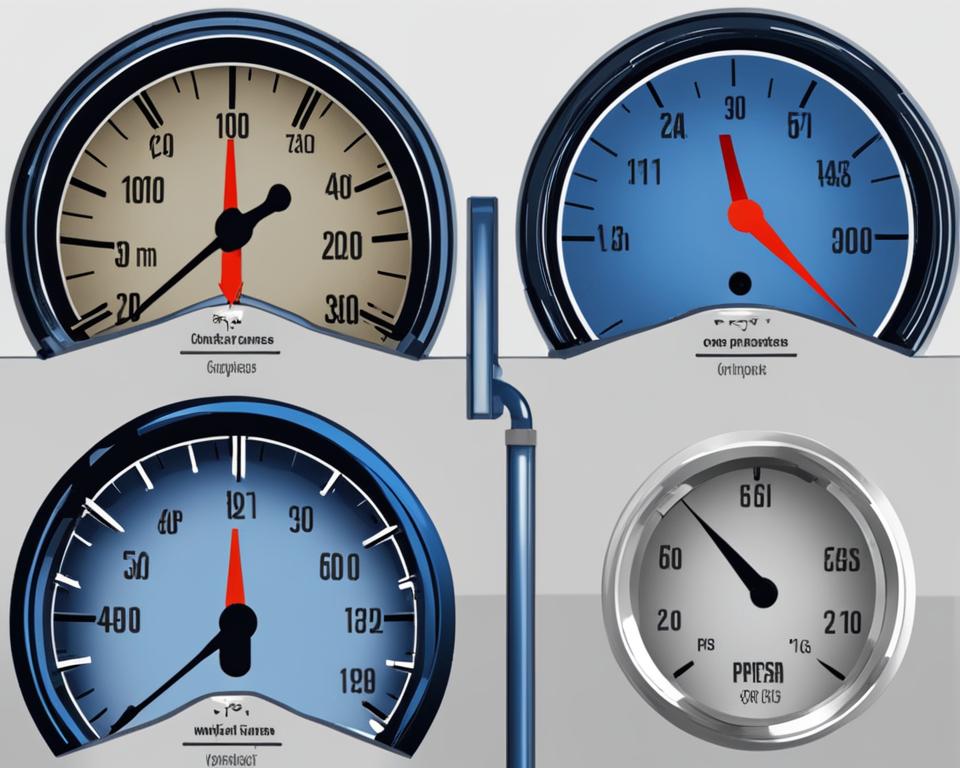When it comes to choosing a pressure washer, understanding the key differences between PSI and GPM is essential. PSI stands for pounds per square inch, which measures the amount of pressure produced by the machine. On the other hand, GPM refers to gallons per minute, indicating the water flow rate. These two factors play a vital role in determining the overall performance and cleaning ability of a pressure washer.
Think of PSI as the “stripping” action that removes dirt and grime, while GPM represents the “flow” that rinses away the loosened debris. The combination of high PSI and high GPM results in better cleaning efficiency, making it easier to tackle tough cleaning tasks.
Contractors and professional cleaners often opt for higher GPM machines as they use cleaning solutions to loosen grime before rinsing it away. However, PSI is still crucial to consider, especially for heavy-duty tasks that require more pressure.
To find the right PSI and GPM for your cleaning needs, it’s important to evaluate the specific tasks at hand. For heavy grime and stains, a higher PSI may be preferred. For larger surfaces or general cleaning, a higher GPM can provide faster and more efficient results.
This article will explore the differences between PSI and GPM in more detail, the importance of finding the optimal balance, and how to maximize performance by understanding their relationship in fluid dynamics.
Key Takeaways:
- PSI refers to the cleaning pressure, while GPM represents the water flow rate of a pressure washer.
- The combination of high PSI and high GPM results in better cleaning efficiency.
- Contractors and professional cleaners often prefer higher GPM machines for better rinsing power.
- The optimal PSI and GPM combination depend on the specific cleaning tasks.
- Understanding the relationship between PSI and GPM can help maximize performance and efficiency.
Understanding PSI (Pounds per Square Inch)
When it comes to pressure washers, PSI is a crucial measurement that determines the cleaning pressure a machine can produce. PSI stands for pounds per square inch and refers to the force applied to the surface being cleaned. A higher PSI indicates greater stripping power, which is essential for tackling tough grime and stains.
Imagine you’re dealing with a stubborn grease stain on your driveway. A pressure washer with a higher PSI will be more effective at breaking down that grease and lifting it away, thanks to its increased cleaning pressure.
Let’s take a closer look at how PSI impacts machine performance:
“Higher PSI means more stripping power, which is crucial for heavy-duty cleaning tasks.”
While PSI is an important consideration, you also need to consider GPM (Gallons per Minute), which measures the amount of water flowing through the pressure washer. The combination of PSI and GPM determines the overall rinsing power of the machine. Having a higher GPM allows for more water flow, which can help rinse away dirt and debris more efficiently. Balancing both PSI and GPM will help you achieve optimal cleaning performance.
Let’s explore the relationship between PSI and GPM in more detail:
Understanding the PSI-GPM Relationship
The PSI-GPM relationship is crucial for understanding how machine performance is affected by these two factors. While a higher PSI offers greater stripping power, a higher GPM provides more rinsing power. Finding the right balance between the two is key to maximizing cleaning efficiency.
| PSI | GPM | Machine Performance |
|---|---|---|
| Low | High | The machine may have limited stripping power but offers efficient rinsing due to a high volume of water flow. |
| High | Low | The machine has strong stripping power but lower rinsing efficiency. |
| High | High | The machine provides both strong stripping power and efficient rinsing, making it ideal for heavy-duty cleaning tasks. |
As seen in the table above, a balance between PSI and GPM is necessary to achieve the desired level of cleaning performance. It’s important to consider the specific cleaning tasks you’ll be performing and choose a pressure washer with the appropriate PSI-GPM combination.
Now that we understand the significance of PSI and its relationship with GPM, it’s clear that finding the right PSI is crucial for achieving effective cleaning results. In the next section, we’ll delve into GPM and explore its role in pressure washer performance and cleaning efficiency.

Exploring GPM (Gallons per Minute)
GPM, or gallons per minute, is a crucial measure of water flow in a pressure washer. It plays a significant role in determining the machine’s rinsing power and its ability to effectively remove dirt and grime. By understanding GPM and its importance, you can make an informed decision when selecting a pressure washer that meets your cleaning needs.
A higher GPM value translates to a greater amount of water flowing from the pressure washer. This increased water flow enhances the machine’s rinsing power, allowing it to effectively rinse away debris and leave surfaces clean and spotless. With a higher GPM, you can achieve faster cleaning results, saving you time and effort.
Contractors and professional cleaners often prioritize pressure washers with higher GPM ratings. These machines are well-suited for heavy-duty cleaning tasks, as they provide ample water flow to ensure thorough rinsing and efficient dirt removal. However, it’s essential to consider both GPM and PSI (pounds per square inch) when selecting a pressure washer, as these factors work hand in hand to deliver optimal cleaning performance.
When choosing a pressure washer, strike the right balance between GPM and PSI to achieve the desired cleaning results. A higher GPM can compensate for a lower PSI, while a higher PSI can enhance the stripping power for tough grime. With the ideal combination of GPM and PSI, you can optimize the cleaning performance of your pressure washer and tackle a wide range of cleaning tasks effectively.

Understanding Cleaning Units (CU)
When comparing pressure washers, one important metric to consider is Cleaning Units (CU). CU is a measurement of machine performance that is obtained by multiplying PSI (pounds per square inch) and GPM (gallons per minute). This metric provides a valuable way to assess the efficiency of different pressure washers and determine their cleaning power.
However, it’s essential to note that two pressure washers with the same CU may have different stripping and rinsing powers. This difference can be attributed to their PSI and GPM values, which play a significant role in the overall cleaning performance of a machine.
Let’s take a closer look at the relationship between PSI and GPM:
| Pressure Washer A | Pressure Washer B |
|---|---|
| PSI: 2000 | PSI: 2500 |
| GPM: 2 | GPM: 2 |
| CU: 4000 | CU: 5000 |
As shown in the table above, Pressure Washer B has a higher CU compared to Pressure Washer A. This suggests that Pressure Washer B has the potential for greater cleaning power. However, it’s important to consider the specific cleaning tasks at hand and the optimal combination of PSI and GPM required.
While a higher PSI generally provides greater stripping power to remove tough grime and stains, a higher GPM offers better rinsing power and faster cleaning results. So, depending on the task, a pressure washer with lower PSI but higher GPM may still be effective and efficient.
Ultimately, when comparing pressure washers, it’s crucial to consider both PSI and GPM values in order to make an informed decision. Analyzing the cleaning units can provide valuable insights into a machine’s performance and help determine the best pressure washer for specific cleaning needs.
Selecting the Right PSI and GPM
When it comes to choosing the perfect pressure washer for your cleaning tasks, it’s important to consider the specific needs and requirements of the job at hand. Selecting the right PSI (pounds per square inch) and GPM (gallons per minute) is essential for achieving optimal cleaning performance.
For heavy-duty cleaning tasks that involve removing tough grime and stubborn stains, a pressure washer with a higher PSI may be the ideal choice. A higher PSI provides greater cleaning pressure, allowing you to tackle even the most challenging cleaning projects with ease.
“A higher PSI can be the key to effectively stripping away dirt and grime, leaving surfaces sparkling clean.”
On the other hand, for larger surfaces or general cleaning tasks where speed and efficiency are paramount, a pressure washer with a higher GPM can deliver faster results. More gallons per minute means a higher water flow, enabling you to cover larger areas quickly and effectively.
The key to finding the optimal combination of PSI and GPM lies in understanding the requirements of your specific cleaning tasks. By evaluating factors such as the surface type, level of dirt and grime, and desired cleaning speed, you can narrow down your options and make an informed decision.
Consulting with professionals or experts in the field can also provide valuable insights and guidance when selecting the right PSI and GPM for your cleaning needs. Their expertise can help ensure that you choose a pressure washer that meets your expectations and delivers exceptional results.
Choosing the Right PSI and GPM for Different Cleaning Tasks
| Cleaning Task | Recommended PSI | Recommended GPM |
|---|---|---|
| Sidewalk cleaning | 1500-2500 PSI | 2-3 GPM |
| Deck cleaning | 1500-2500 PSI | 2-3 GPM |
| Car washing | 1200-1500 PSI | 1.5-2 GPM |
| Heavy equipment cleaning | 3000-4000 PSI | 4-5 GPM |
| House/siding cleaning | 2000-3000 PSI | 2.5-3.5 GPM |
Remember, selecting the right PSI and GPM is crucial for achieving optimal cleaning results. By considering your specific cleaning tasks and seeking professional advice, you can confidently choose a pressure washer that meets your needs and delivers outstanding performance.

Maximizing Performance with PSI and GPM
When it comes to maximizing the performance of a pressure washer, understanding the relationship between PSI (pounds per square inch) and GPM (gallons per minute) is crucial. The PSI determines the cleaning pressure, while the GPM influences the water flow. By selecting the right combination of PSI and GPM, you can optimize the fluid dynamics of the pressure washer for efficient cleaning.
To illustrate the importance of this selection, let’s consider the impact on both cleaning effectiveness and appliance performance.
Optimizing Cleaning Effectiveness
By carefully comparing the available water pressure options, considering your specific cleaning task requirements, and choosing the ideal PSI and GPM values, you can maximize the cleaning performance of your pressure washer. The right combination will ensure that you have sufficient cleaning pressure to remove dirt and grime effectively, combined with the necessary water flow to rinse away debris.
Remember, a higher PSI provides greater stripping power, making it ideal for tackling stubborn stains and deeply embedded grime. On the other hand, a higher GPM offers more rinsing power, allowing for faster cleaning by providing a higher flow of water. By finding the right balance between PSI and GPM, you can achieve optimal cleaning results.
Enhancing Appliance Performance
The selection of the appropriate PSI and GPM values also impacts the performance of your appliances, especially those that rely on consistent and adequate water pressure. By ensuring that your pressure washer generates the correct water pressure, you can optimize the performance of appliances such as dishwashers, washing machines, and irrigation systems. This is particularly important for their efficient functionality and longevity.
Additionally, considering the fluid dynamics of both PSI and GPM ensures that your pressure washer operates at its peak performance, prolonging its lifespan and reducing the risk of damage caused by inadequate water pressure.
To further explain the importance of maximizing performance with PSI and GPM, let’s take a look at the following comparison table:
| Pressure Washer | PSI | GPM | Cleaning Units (CU) |
|---|---|---|---|
| Pressure Washer A | 2500 | 2.0 | 5000 |
| Pressure Washer B | 2000 | 2.5 | 5000 |
| Pressure Washer C | 3000 | 1.7 | 5100 |
As shown in the table above, Pressure Washer A and Pressure Washer B have the same Cleaning Units (CU) value but differ in their PSI and GPM values. This demonstrates that the CU value alone does not provide a complete picture of a pressure washer’s cleaning ability. It is essential to consider the specific PSI and GPM combinations to determine the stripping and rinsing power for effective cleaning.
By taking into account both PSI and GPM, comparing options, and considering the unique needs of your cleaning tasks, you can maximize the performance of your pressure washer, achieve optimal cleaning results, and ensure proper appliance functionality.
Continue reading the conclusion to understand how the right combination of PSI and GPM is crucial for effective cleaning and to find the optimal PSI and GPM based on your specific needs.
Conclusion
When it comes to choosing a pressure washer for effective cleaning, understanding the relationship between PSI and GPM is crucial. PSI determines the cleaning pressure, while GPM influences the water flow. The right combination of these two factors will depend on your specific cleaning tasks and preferences.
By carefully selecting the optimal PSI and GPM, you can achieve the desired cleaning results. Whether you need to tackle tough grime or cover large surfaces quickly, finding the right pressure washer with the perfect balance between PSI and GPM is key.
Remember, it’s not just about the numbers. Considering the psi-gpm relationship and its impact on fluid dynamics and appliance performance can help ensure that you choose a pressure washer that meets your specific needs. So take the time to compare options, understand your cleaning requirements, and make an informed decision to maximize the effectiveness of your pressure washer.
FAQ
What is the difference between PSI and GPM?
PSI refers to the amount of pressure produced, while GPM indicates the amount of water flow.
How do PSI and GPM affect the cleaning ability of a pressure washer?
The combination of PSI and GPM determines the effectiveness of a pressure washer’s cleaning ability. PSI provides the “stripping” action, while GPM provides the “flow” that rinses away dirt and grime.
What is Cleaning Units (CU)?
Cleaning Units (CU) is a measurement of machine performance obtained by multiplying PSI and GPM. It provides a way to compare different pressure washers’ efficiency.
Are PSI and GPM equally important when choosing a pressure washer?
While both are important, the optimal combination of PSI and GPM will depend on the specific cleaning tasks at hand. For heavy-duty tasks, a higher PSI may be preferred. For large surfaces and general cleaning, a higher GPM can provide faster results.
How can I maximize the performance of a pressure washer with PSI and GPM?
By selecting the right combination of PSI and GPM, you can optimize the fluid dynamics of the pressure washer for efficient cleaning. This selection can also impact the performance of appliances, such as ensuring proper water pressure for optimal functionality.
How do I select the right PSI and GPM for my pressure washer?
It is important to consider the specific cleaning tasks and preferences. Consulting with professionals or experts can help determine the best PSI and GPM for your specific cleaning tasks.
What is the importance of understanding the PSI-GPM relationship?
Understanding the relationship between PSI and GPM can help you make informed decisions when selecting a pressure washer. It allows you to compare different models and determine the optimal combination of PSI and GPM for your cleaning needs.
